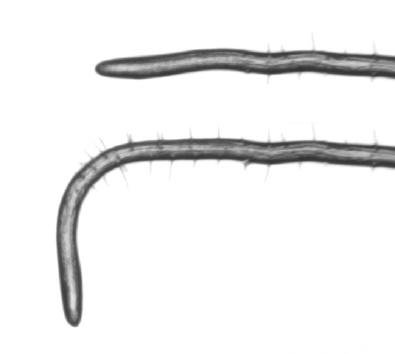Gravitropism Results
The image below shows a root immediately after rotation and after six hours of gravitropism. Images acquired every two minutes during the process provide detailed information about the progression of this hormonally-mediated response to a physical aspect of the environment. You may watch a movie of the entire ten hour experiment. The example shown here is an Arabidopsis root but the techniques developed to quantify root growth and shape have successfully applied to other species such as Medicago, maize, and tomato.

Images such as those shown here are analyzed with image processing algorithms. Methods are continuously evolving, being perfected and adapted to different experimental scenarios. Subtle but informative root gravitropism phenotypes have been detected and quantified using these custom methods.
Publications
(2010) Detection of a gravitropism phenotype in glutamate receptor-like 3.3 mutants of Arabidopsis thaliana using machine vision and computation. Genetics 18, 585–593.
(2010) Plasticity of Arabidopsis root gravitropism throughout a multi-dimensional condition space quantified by automated image analysis. Plant Physiology 152, 206–216.
(2007) Computer-vision analysis of seedling responses to light and gravity. The Plant Journal 52, 374–381.
(2007) Separating the roles of acropetal and basipetal auxin transport on gravitropism with mutations in two Arabidopsis Multidrug Resistance-like ABC transporter genes. The Plant Cell 19: 1838–1850.